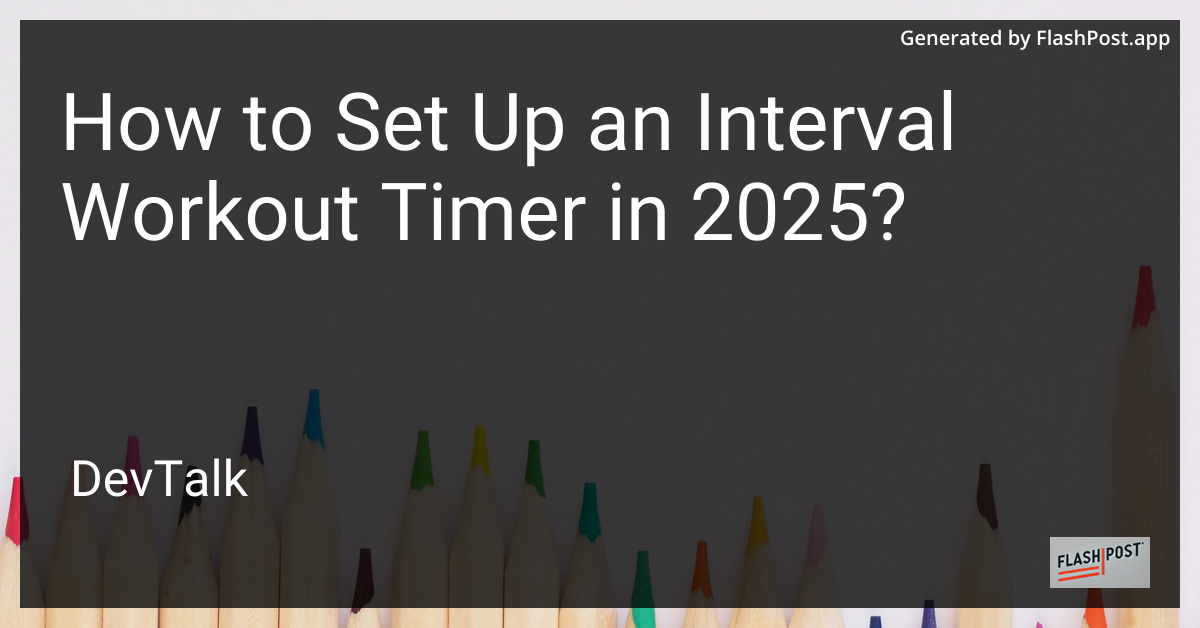How to Set Up an Interval Workout Timer in 2025?

How to Set Up an Interval Workout Timer in 2025
In the world of fitness, interval workouts—short bursts of intense exercise followed by rest or low-intensity periods—have gained immense popularity for their efficiency and effectiveness.
Whether you are a runner, a cyclist, or someone working out at home, setting up an interval workout timer is essential for maximizing your performance. This guide will delve into how you can set up an interval workout timer in 2025, ensuring you have the best tools and strategies at your disposal to meet your fitness goals.
Why Use an Interval Workout Timer?
Interval training can significantly enhance your cardiovascular fitness, boost your stamina, and help in efficient fat burning. However, without a proper timing system, it's challenging to maintain the intensity and focus required. An interval workout timer helps in:
- Keeping track of active and rest periods.
- Enhancing workout efficiency.
- Reducing the chance of over-training or under-training.
Step-by-Step Guide to Setting Up Your Interval Workout Timer
1. Choose the Right Timer
With advancements in technology, 2025 offers a variety of options for interval workout timers, from smartphone apps to wearable devices and standalone digital timers.
- Smartphone Apps: Apps like "HIIT Timer" and "Interval Timer Pro" offer customizable interval settings. They provide audio and visual alerts, making it easy to transition between stages of your workout.
- Wearables: Modern fitness watches with built-in interval timers can give vibration alerts, providing an advantage if you're in a noisy environment.
- Standalone Devices: If you prefer simplicity, standalone digital timers with pre-set interval programs are available in sports shops or online.
2. Set Your Interval Details
Once you have chosen your timer, the next step is to set the specifics. Consider:
- Work Period: The duration of your high-intensity phase. Beginners might start with 30 seconds, while seasoned athletes could extend this to 2 minutes.
- Rest Period: Essential for recovery. Typically, equal or longer than the work period, depending on fitness levels.
- Number of Rounds: Decide how many intervals you want to complete. A standard session could range from 5 to 10 rounds.
3. Customize Alerts
Ensure that your timer is set to alert you effectively. Consider using:
- Sound Alerts: Beeps or notifications to signal the end of an interval.
- Vibration Alerts: If you’re using wearables, vibrations can be a subtle and effective reminder.
- Visual Alerts: For those who need a clear signaling system, flashing lights or changes in screen color can help.
4. Test Your Timer
Before your workout, do a brief test run. This will help in adjusting any settings and ensuring that you can hear, feel, or see the alerts clearly during your workout.
5. Sync with Your Workout Routine
Integrate your newly set timer with your workout routine. Whether you’re on a treadmill, using a rowing machine, or following a personalized plan, your timer should sync well with your activity for optimal results.
Enhance Your Workouts
Once you’re accustomed to using an interval timer, consider incorporating it into various workouts for better efficiency and outcomes. For more detailed training plans and ideas, explore these additional resources:
- Discover how incline treadmill training benefits athletes
- Explore notable treadmill workout plans for 2025
Conclusion
Setting up an interval workout timer in 2025 can revolutionize your fitness routine by providing structure and focus. With the right tool in hand, you're well on your way to achieving enhanced physical fitness. Remember, consistency is key, so keep challenging yourself with new interval goals and keep pushing the limits of your endurance!
Get ready, set your timer, and make your workouts more efficient and enjoyable today!